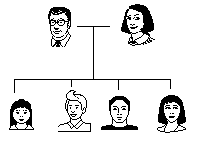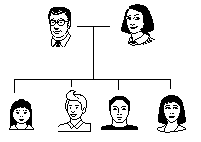











��
| G3.1 �־��/����� as expression of possession |
1. Following the model dialogues,
practice�־��/�����
with the items given below.
Note
the uses of different particles depending on the context.
����
| [�ð�, ��, ��ǻ��] | |||||
| (1) | A: | ...��,
�ð�
��������?
|
(2) | A: | ...��, �ð� ��������? |
| B: | ��, �־��. | B: | �ƴϿ�, �����. | ||
| A: | ��ǻ���� ��������? | A: | ��ǻ���� ��������? | ||
| B: | �ƴϿ�, ��ǻ���� �����. | B: | �ƴϿ�, ��ǻ���� �����. | ||
| A: | ��, ���� ��������? | A: | ��, ���� ��������? | ||
| B: | �ƴϿ�, ���� �����. | B: | ��, ���� �־��. | ||
 |
 |
 |
�� |
������ |
iPod
|
 |
 |
 |
ī��Ʈ �÷��̾� |
�ڷ�����/���� |
DVD Player |
 |
 |
 |
��ǻ�� |
������
|
ī��/��īiPod |
 |
 |
 |
�� |
������ |
ũ����ī�� |
2. Following the model dialogue, practice family terms and their locations.
����
| A: |
���� ���? [Where is your home?] (cf. ��� �缼��?) |
| B: | ....-�̿���/����. |
| A: | �θ���� ...-�� �輼��? [��ô� is an honorific verb for �ִ� (existence)] |
| B: | ��. |
| A: | ...-�� �� ���� �־��? |
| B: | ...-��/�� �־��/�θ�Ը� �־��. |
| A: | ...-��/�� �����? |
| B: | �־��. ...-�� �־��/��, �����. |
| A: | ...-�� �� ���� �־��? |
| B: | ...-��/�� �־��/�θ�Ը� �־��. |
For Male Ego For Female Ego
�ƹ��� ��Ӵ� �ƹ��� ��Ӵ�


(��)���� �� �� ���� �� (����)���� (ū)���� ���
<----younger . ................ older ----> <----younger . ................ older ---->
For pronunciation of these terms, see Multimedia Dictionary (#13 and #14).
Two uses of �־��/�����
(i) Existence of an object or person in a location (ii) Possession (Existence of an object or person to a person)